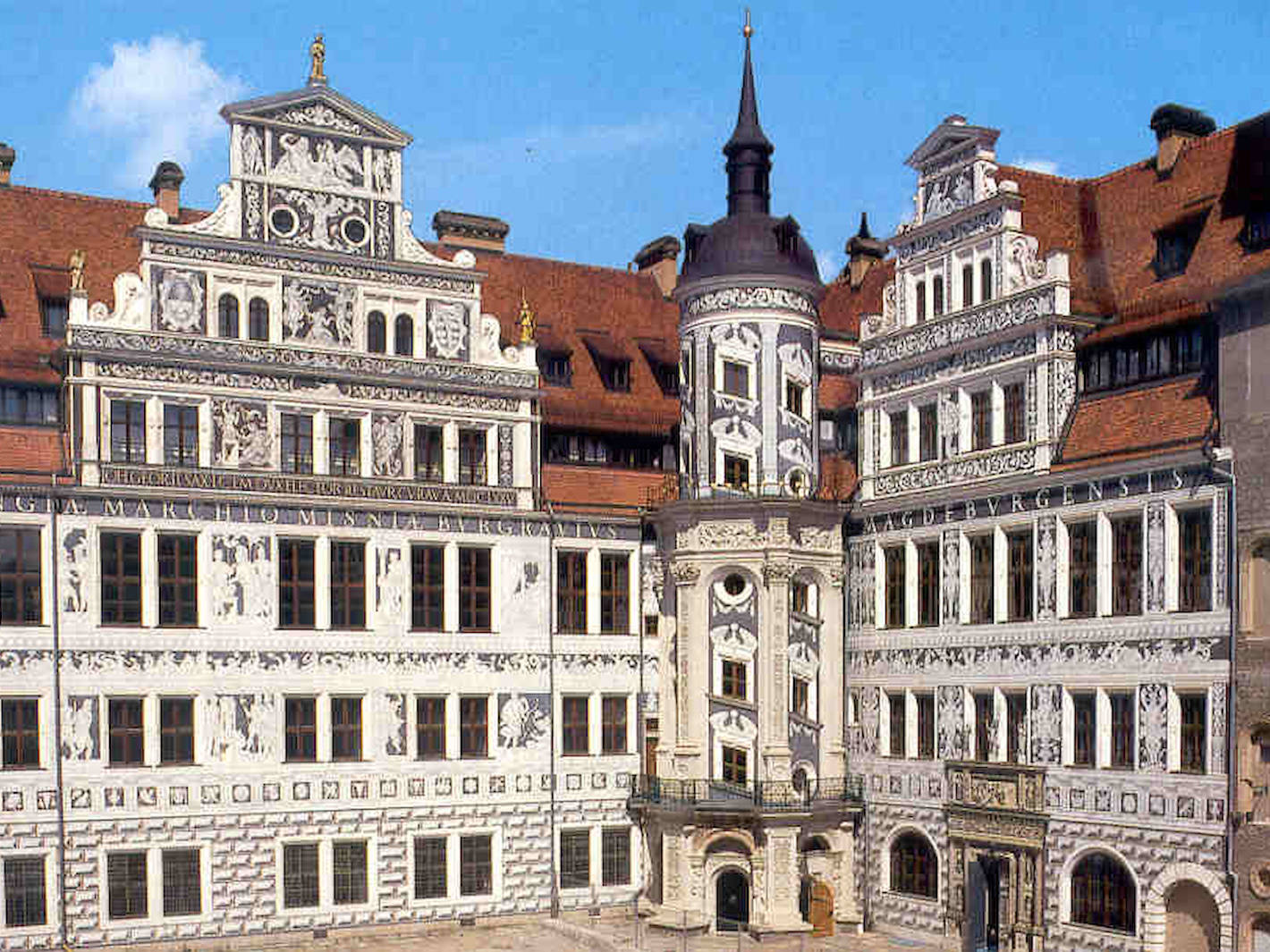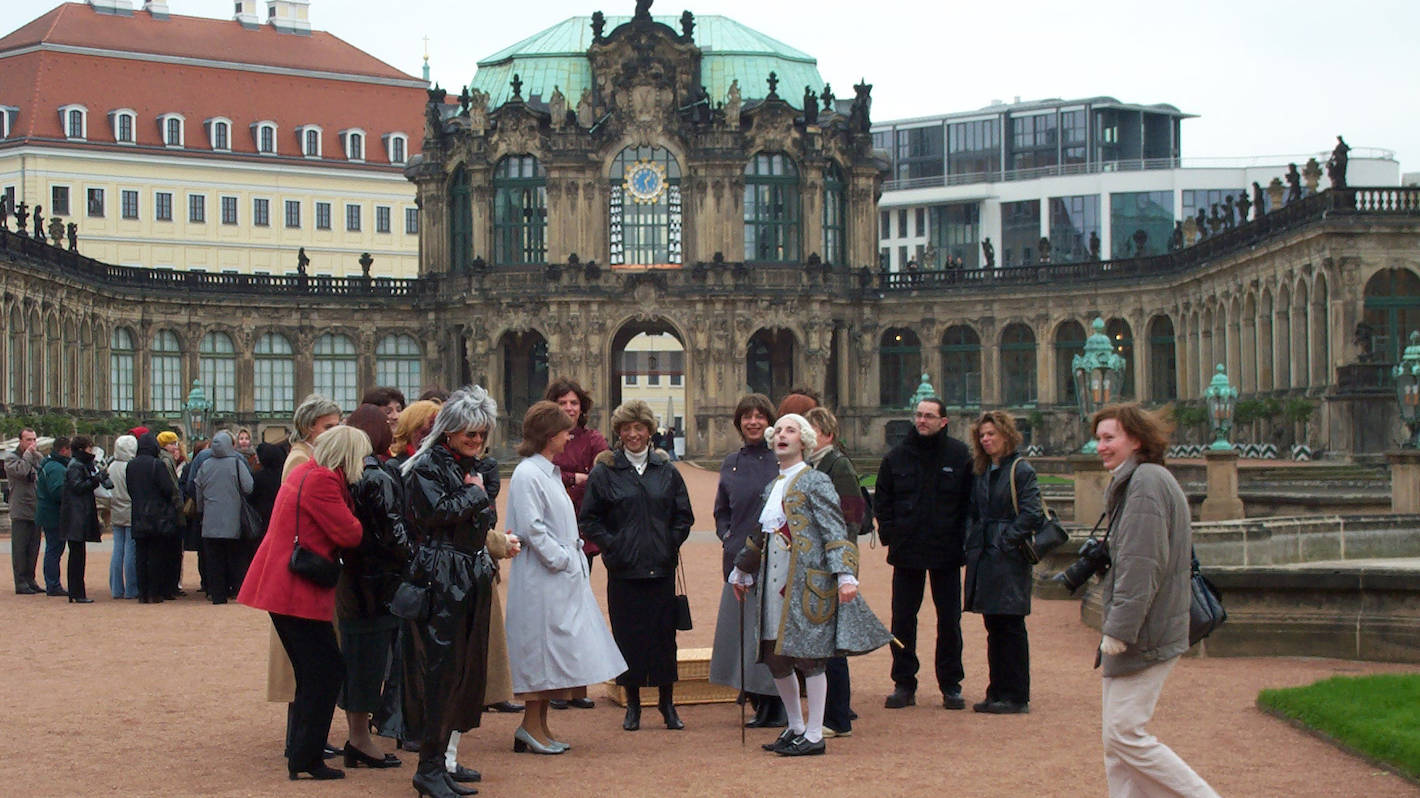Museums
Dresden is home to some of the most renowned and oldest museum institutions in the world. The city is not only an important cultural and artistic centre for Germany, but also a research and science centre, which guarantees a wide range of museums of all kinds.
The oldest museums, often containing the works of art and treasures acquired by the Saxon electors since the 14th century, are of course located in the old heart of the city: the Baroque Old Town.
A Catholic court church in Protestant Saxony?
We cross the river once more on the imposing Augustus Bridge, leaving the Catholic Court Church on our right as we reach the gates of the Old Town. As we pass under the raised footbridge between the church and the palace, we try to imagine Augustus the Strong striding through the footbridge as the angry crowd rages against him. The history of this passageway and the church is indeed emblematic: the cathedral was completed in 1751 by order of August the Strong. The Saxon king had in fact decided to convert to Catholicism, and to have this cathedral built in the immediate vicinity of the royal palace, in order to be able to apply more easily for the title of king of Poland. Imagine the anger of the traditionally Protestant Saxons when they saw their king going to a Catholic church every Sunday to attend mass. To avoid insults and maybe even tomatoes on his face every Sunday morning, Augustus decided to connect the castle and the church with an elevated passageway, covered and well protected from the people!

the most important museums in the old town
After this little journey into the past, we come to a clearing. In front of us is the Zwinger, a magnificent Baroque complex that houses 3 museum collections, which we will return to later. We now turn left and head for the entrance to the Residenzschloss. This is a royal palace from the Renaissance period, and we can easily call it the most visited sight in the city. It is the centrepiece of the history of the Electorate of Saxony, and holds a wide variety of treasures: Europe's largest collection of crown jewels in the Green Vault, the Armoury, full to the brim of armour, weapons and saddles (many of which were collected between the 7th and 18th centuries), the Coin Cabinet, the Museum of Prints and Drawings, or the opulent Royal Parade Rooms of August the Strong. Visiting the castle therefore allows us to visit 4 different museums: so make sure to have enough time to see everything!
Another whole day is to be dedicated to the Zwinger, a complex built by Augustus the Strong for his son's wedding and later used for court tournaments and banquets of all kinds. Today, the baroque complex of pavilions, galleries and courtyards houses world-class museums, including the Old Masters Picture Gallery, which displays Raphael's famous Sistine Madonna alongside countless world-famous works of art. In the Zwinger we also find the rich Porcelain Collection and the Mathematical-Physical Salon.

wait, there is more
When we leave the Zwinger and go back to the river, we can turn right. Let's walk along the other side of the cathedral and up a flight of stairs to the Brühl Terrace. Walking along it, we will find two particularly interesting buildings on the right: the Lipsius Bau and the Albertinum, also known as the New Masters Painting Gallery. The first building, whose glass dome is also known to the locals as the "lemon squeezer", houses special exhibitions and an exploration of contemporary art. The second building houses an art gallery and a collection of sculptures from 1800 to the present day. The works of art preserved here are among the most famous in the world.
If we stay on the southern side of the river, we can really spend whole days visiting museums. Here we still find, for example, the Dresden City Museum, the Transport Museum and the Technical Collections, interesting exhibitions on German, mainly Saxon, industrial and technical history. For those with a sweet tooth, there is also the Camondas Schokoladenmuseum, the museum of Camondas, Kontore and Kakaostube in Dresden, founded in 2019.

Unique in Germany: The Hygiene Museum
If we're in the mood for more interactive and exciting experiences, we shouldn't miss the German Hygiene Museum. The museum was founded in 1912 by the Dresden entrepreneur Karl August Lingner after the I International Hygiene Exhibition as a "popular education centre for health care". In particular, knowledge of human anatomy was taught here, but questions of healthy nutrition, personal hygiene and preventive health care were also addressed. Today, the museum sees itself as a public forum for science, culture and society.
Fascinating experiences
For an all-round audiovisual experience that will delight even the youngest visitors, we recommend a visit to the Festung Xperience to discover the secrets of Dresden's fortress, and to the Panometer to take a journey back in time to Dresden's past and get to know the city as a 360° panorama.

Museums on the Neustadt side
Neustadt(-side): Galerie Holger John, Radio Körner (Konkordienplatz) (t was once a shop but no longer; now it is a gallery under the same name), Erich-Kästner-Museum (definitely go in!) on Albertplatz.
For nostalgics, new generations who didn't experience the GDR, vintage lovers, Instagrammers or simply those who want to learn more about everyday life in East Germany before the fall of the Wall, there's a perfect place to spend a few hours: the World of the GDR. This museum, which is almost more like an installation, a reconstruction of the historical surroundings, is located in a small but modern shopping centre, so when you come out you really feel like you've travelled back in time!
Japanese Palace (which hosts the wonderful Palaisommer festival every year with a variety of free events), Kraszewski Museum (for German-Polish dialogue; dedicated to Polish author), Military History Museum, Kügelgenhaus (Hauptstraße; art, literature and music museum/period of Romanticism), BRN Museum in the Stadtteilhaus, Museum aktfotoARTdresden in the Kunstkeller (it's all about nudes ;)), Galerie Raskolnikow.

